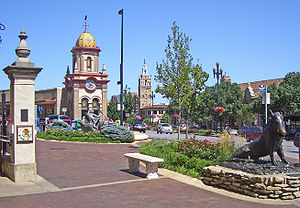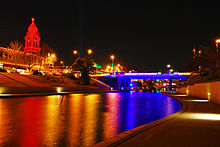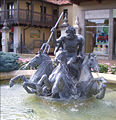- Country Club Plaza
-
The Country Club Plaza (often referred to as The Plaza) is an upscale shopping district and residential neighborhood in Kansas City, Missouri, USA. It was the first shopping center in the world designed to accommodate shoppers arriving by automobile.[1] The 55 acre (223,000 m²) site is about four miles (6.44 km) south of downtown, between 45th and 51st streets to the north and south and between Broadway and Madison Street to the east and west. The Kansas state line is one mile (1.6 km) to the west. Established in 1922 by J. C. Nichols and designed architecturally after Seville, Spain, the Plaza comprises high-end retail establishments, restaurants, and entertainment venues, as well as offices.[1] The neighborhoods surrounding the Plaza consist of apartment buildings and upscale houses, especially those of the Country Club District built along Ward Parkway on the Plaza's southern and southwestern side. The Country Club Plaza is named in the Project for Public Spaces' list 60 of the World's Great Places.
Contents
History
The Country Club Plaza was named for the associated Country Club District, the neighborhood developed by J.C. Nichols which surrounded the Kansas City Country Club (now Loose Park). It is situated at the northern terminus of Ward Parkway, a boulevard known for its wide, manicured median lined with fountains and statuary that traverses the Country Club District. J.C. Nichols selected the location carefully to provide residents with a direct route to the Plaza along Ward Parkway.
Nichols began acquiring the land for the Plaza in 1907, in an area of Kansas City that was then known as Brush Creek Valley. When his plans were first announced, the project was dubbed 'Nichols' Folly' because of the then seemingly undesirable location; at the time, the only developed land in the valley belonged to the Country Day School (now the Pembroke Hill School), and the rest was known for pig farming.[citation needed] Nichols employed architect Edward Buehler Delk to design the new shopping center. The Plaza opened in 1923 to immediate success, and it has lasted with little interruption since that year. New Urbanist land developer Andres Duany noted in Community Builder: The Life & Legacy of J.C. Nichols that the Country Club Plaza has had the longest life of any planned shopping center in the history of the world. One of the oldest stores on the plaza is the Jack Henry Clothing company, which was founded in 1931.
For its first four decades, the Plaza combined some higher-end shops, such as Harzfeld's, with a mix of more mainstream retailers such as Sears and Woolworth's, as well such quotidian enterprises as a bowling alley, movie theater, and a grocery store to serve the daily needs of residents of the district.[citation needed] From around 1970, competition from newer suburban shopping malls led management to reposition the Plaza with luxury hotels such as the Ritz-Carlton Hotel, boutiques, higher end chain restaurants, and upscale retailers including Tiffany & Co., Gucci, FAO Schwarz, Saks Fifth Avenue, Macy's, Coach Inc., Bonwit Teller, The Sharper Image and Halls.[2] On September 12, 1977, a major flood of Brush Creek caused severe damage to the Plaza and resulted in a number of deaths. The flood prompted a vast renovation and revitalization of the area that has allowed it not only to survive but to thrive.
In 1998, the J.C. Nichols Company merged with Raleigh, North Carolina-based real estate investment trust Highwoods Properties, who now runs the Country Club Plaza.[3]
Competing claims
The Country Club Plaza is generally credited as the first regional shopping center designed for automobile use. Other shopping centers, however, have been the subject of competing claims often based on different definitions. Roland Park Shopping Center (1907) in Baltimore, a small six-store strip, has been credited as the "world's first shopping center" by Guinness World Records. Suburban Square (1928) in the Philadelphia area was previously credited by Guinness as first, though clearly predated by Country Club Plaza. Market Square (1916) in Illinois was a planned central retail district in an already developed area. And Highland Park Village (1931) in Texas is generally credited as the first "self-contained" shopping center, i.e., where the stores were turned inward instead of along planned cross streets.
Layout and use
The basic design of the Country Club Plaza reflects classic European influences, especially those of Seville, Spain, yet it curiously does not include a traditional open plaza. There are more than thirty statues, murals, and tile mosaics on display in the area, as well as major architectural reproductions, such as a half-sized Giralda Tower of Seville (the tallest building in the Plaza). The Plaza also includes precise light fixture reproductions of San Francisco's Path of Gold streetlights. Other works of art celebrate the classics, nature, and historical American themes such as westward expansion.
Although the Plaza was designed and built to accommodate visitors arriving by automobile, it is unlike modern shopping malls with sprawling parking lots: parking is discreetly concealed in multilevel parking garages beneath and behind the shops, or hidden on the rooftops of buildings. Thus the Plaza does not suffer from the sprawl that afflicts modern shopping centers, and this design makes it friendly to pedestrians.
The Plaza was also the first shopping center to use the percentage lease, where rents are based on a percentage of the gross receipts of tenants.[citation needed] This concept was novel at the time when J.C. Nichols invented it, but it is now a standard practice in commercial leases. The fountain with four equestrian statues, designed by Henri-Léon Gréber, was purchased from a Long Island Gold Coast Estate, Harbor Hill.
Several companies are based in the Country Club Plaza area, including American Century Investments, Russell Stover Candies, Inergy and Gates Bar-B-Q. The Kansas City Board of Trade is also located in the district.
Plaza Lights
In 1925, a tradition began with a single strand of 16 colored lights placed above a doorway in the Country Club Plaza to celebrate Christmas.[4] Through the years, the number of lights have increased annually. The first official "Plaza Lighting Ceremony" took place in 1930. On Thanksgiving night, tens of thousands of people visit the Country Club to enjoy the local entertainment/performances (including celebrities) and to watch the electric lights (including fireworks) to initiate the Christmas season.[5][6] A special guest or celebrity "flips the switch" each year.[7] In its 81st year (as of 2010), the Country Club Plaza’s "Season of Lights" is a Kansas City winter trademark and one of the city's longest/oldest traditions.[8] According to sources, it's considered the most spectacular holiday lighting display in the nation.[9] More than 80 miles of Christmas lights accentuate every dome, tower and window of the Plaza’s Spanish-influenced entertainment district, featuring more than 150 shops and restaurants.[10][11] The lights currently shine nightly from 5 p.m. until 3 a.m. into mid-January of the following year (ie. January 17 in 2011).[12] The 1-2 hour ceremony is free and broadcasts live on local television.[13] A century-old tradition of holiday lights and seasonal attractions also extends into neighboring Crown Center.[14]
The song "Christmas In Kansas City", sung by Brad Millison and recorded in 1985, got considerable airplay on KC radio (KUDL) during the holiday season. It expresses the sights-and-sounds of the Country Club Plaza in Kansas City during Christmastime.[15]
Plaza Art Fair
In 2011, The Country Club Plaza celebrated it's 80th annual Plaza Art Fair featuring over 240 artists on display from September 23rd through September 25th.[2]
Building Controversy
A 2010 proposal by the law firm of Polsinelli-Shughart to construct an eight-story building was abandoned in April 2011 following strong community resistance objecting to changing the low rise character of the Plaza and the fact that it would be a modern tower as opposed to keeping the Spanish architecture character.[3] It would have been located at 47th & Broadway.[4]
Gallery
See also
- List of neighborhoods in Kansas City, Missouri
- List of shopping malls in the United States
- List of largest shopping malls in the United States
References
- ^ http://retailtrafficmag.com/mag/retail_nichols_folly/
- ^ "Plaza Art Fair in it's 80th Year". Kansas City News. September 24th, 2011. http://www.kansas-city-news.pro/2011/09/plaza-art-fair-2012-band-lineup-kansas.html.
- ^ http://www.kmbc.com/r/27445686/detail.html
- ^ http://www.nbcactionnews.com/dpp/news/local_news/historic-kansas-city-foundation-to-protest-proposed-plaza-building
External links
- Country Club Plaza - Official Website
- Nichols' Folly
- Great Public Spaces | Project for Public Spaces (PPS) - Country Club Plaza
- Ward Parkway: a Grand American Avenue
- Planning for Permanence -- the speeches of J.C. Nichols
Coordinates: 39°02′29″N 94°35′31″W / 39.041323°N 94.591813°W
The Kansas City Area Kansas City • The Metro Area • History • Economy • Neighborhoods • Architecture • Fountains • Barbecue • Jazz • Broadcast • Film • Education • SportsEnclosed Lifestyle/Outdoor Corbin Park • Country Club Plaza • Leavenworth Plaza • The Legends at Village West • Summit Woods Crossing • Town Center Plaza • Ward Parkway Center • Zona RosaDefunct Antioch Shopping Center • Bannister Mall • Blue Ridge Mall • Indian Springs Mall • Mission Center Mall • Riverfront MallCategories:- Shopping malls in Missouri
- Economy of Kansas City, Missouri
- Shopping districts and streets in the United States
- Neighborhoods in Kansas City, Missouri
- Buildings and structures in Kansas City, Missouri
- 1923 establishments in the United States
- Visitor attractions in Kansas City, Missouri
Wikimedia Foundation. 2010.


















